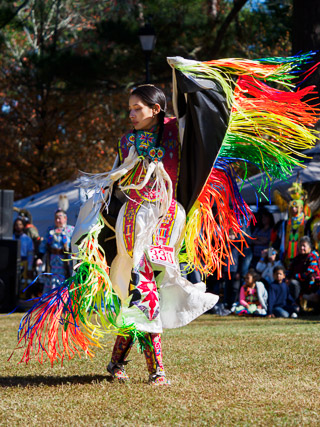The background of a photograph is just as important, and sometimes more important than the main subject of the photograph. I was reminded of this last weekend when I attended the Native American festival and powwow at Stone Mountain Park here in Georgia.
One of the highlights of the festival is the dance and drumming competitions. The contestants wear beautiful elaborate costumes as they demonstrate many different styles of Native American dancing. My kids and I make it a point to attend this event every year.
It’s very important to control the background when photographing the dance competitions. A distracting or unrelated background can ruin the feel of an image, while an appropriate background can make the difference between a snap-shot and a professional photo.
The dancers compete in a large ring surrounded by bleachers, people in lawn chairs, a portable stage, and many other undesirable background elements. Obviously you can’t control how these elements are arranged around the ring, so you have to control the background by choosing your shooting position.
The direction and quality of light are the first things to note. Choose a place to set up where the light (in this case the sun) falls in a pleasing way on your subject. I decided to shoot with the sun over my right shoulder to avoid shadows on the dancers’ faces.
Now that you have decided where to shoot from, have a look at your background options.

There were two areas I noticed immediately. There was a tree with beautiful fall leaves to my right. from my low shooting angle I could use this as a background for close-up shots and avoid including the busy tents at ground level in my shots. There was also an area directly across the arena from me that was mostly darker colors and slightly shaded. I knew that if I expose for the highlights on my subject, the shaded background would be mostly unnoticed.

Now here is the part that requires a bit of discipline. Concentrate on the areas of the arena that have the background you like, and understand that the best images are probably going to come from these areas. You are basically deciding on the frame for your photos and waiting for the action to happen where you want it. Of course you can shoot the entire arena, but the shots with tourists in the background or a big white tent just aren’t going to be as engaging.
This same technique is a great way to shoot street photography, and even sports and wildlife. Although with sports and wildlife we are usually forced to react to the movements of the subject, and there is rarely time to wait for the perfect moment to happen in the perfect spot. If you can be patient enough to try it, you’ll be rewarded with some amazing shots!
The photos in this post were all captured with the Olympus E-M1X camera and the Olympus 40-150mm f2.8 pro lens.






Good info. Thanks for posting.
Thanks Mary! My pleasure